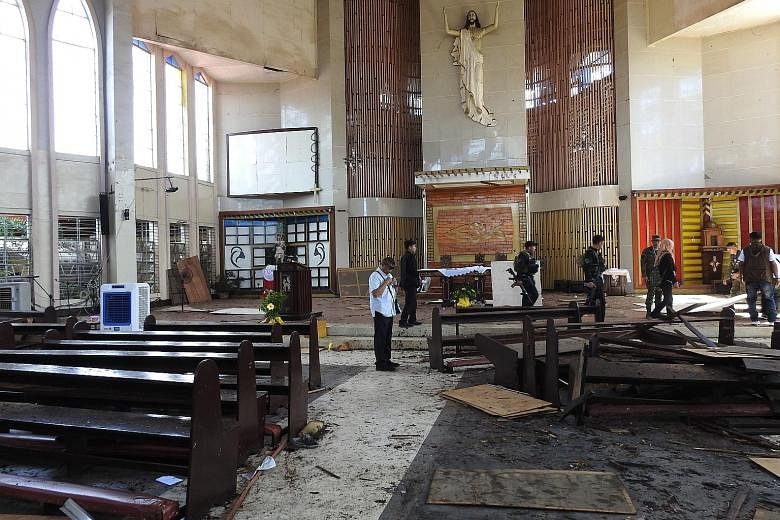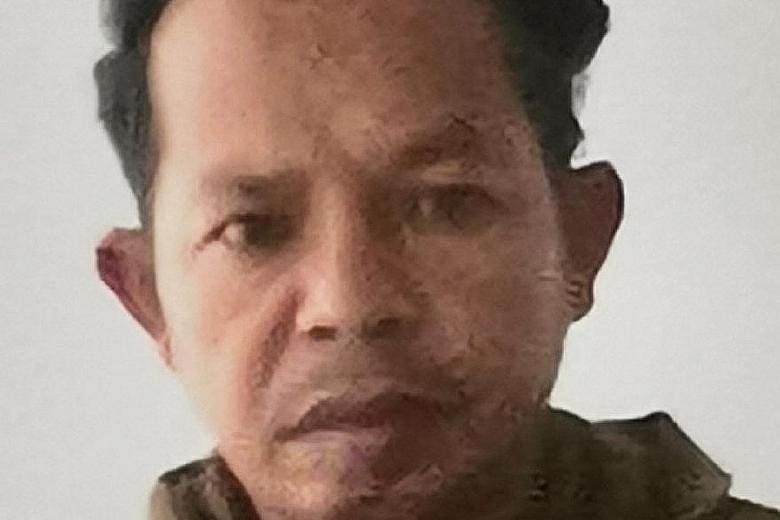A man suspected of helping two suicide bombers carry out the deadly twin blasts on the small Philippine island of Jolo has surrendered, security officials announced yesterday.
Kammah Pae and four other supposed operatives of the Abu Sayyaf - a gang of self-styled Muslim militants that has pledged allegiance to the Islamic State in Iraq and Syria (ISIS) - turned themselves in at the weekend, director-general Oscar Albayalde, the national police chief, told a news conference.
Kammah is said to have conspired with the Indonesian couple who blew themselves up minutes apart, one inside and the other outside a Roman Catholic cathedral on tiny Jolo Island, in the largely Muslim province of Sulu, on war-torn Mindanao Island, on Jan 27.
The explosions killed 23 people and wounded more than 100.
"This was a plain act of terror… to get funds from ISIS. They want to gain international notoriety… so ISIS will funnel funds to them," said Mr Albayalde.
He said the Indonesians sailed south-west to Jolo from Lampinigan island, in Basilan province, on Jan 24. They were in Lampinigan "for a few days".
Mr Albayalde said the male suspect, identified by his nom de guerre Abu Hud, had been in Mindanao for about a year, while the woman arrived days before the attack.
It could not be ascertained whether they travelled to the Philippines directly from Indonesia.
For three days, Kammah provided the Indonesian couple with shelter and escorted them around the island, where the two met Hatib Sawadjaan, the purported ringleader of the Ajang-ajang faction of the Abu Sayyaf.
The Indonesians were taken to Jolo's main town late on Jan 26. The following day, around 8.30am, both set off pipe bombs hidden inside bags that tore across the Cathedral of Our Lady of Mount Carmel.
Mr Albayalde said Sawadjaan and his Ajang-ajang cohorts had plotted the attack for "almost a year".
He said security forces were still hunting 14 more suspects, including Sawadjaan and another Indonesian.
Sawadjaan is the father-in-law of Malaysian militant Amin Baco.
Baco, who has had lengthy experience fighting a guerilla war in Sulu, was once rumoured to have been designated as ISIS' "emir" in South-east Asia, replacing Isnilon Hapilon, the Abu Sayyaf chieftain killed in the five-month siege in 2017 of the southern city of Marawi.
Kammah is purportedly the brother of Surakah Ingog, a slain Abu Sayyaf fighter.
"Ajang-ajang" is an ethnic term in Sulu that means "sons of warriors" or "sons of martyrs".
Before the cathedral bombings, the Ajang-ajang had acted as low-level enforcers of the Abu Sayyaf.
It had never ventured out of Jolo, and mostly stuck to extortion, drug dealing and spotting hostages for the Abu Sayyaf.
The probe into the bombings has been fraught with inconsistent and sometimes contradictory accounts from the authorities.
Security officials had initially said the two bombs were remotely detonated. But that changed after President Rodrigo Duterte said it may have been a suicide bomber, a view supported by Defence Secretary Delfin Lorenzana.
Meanwhile, citing information provided by witnesses and undisclosed sources, Interior Secretary Eduardo Ano said he was certain an Indonesian couple were behind the attack.
"They are Indonesians," Mr Ano, a former military chief, told CNN Philippines. "I am certain that they are Indonesians."
The aim, he said, was to foment sectarian conflict in Mindanao, which covers a third of the Philippines and is home to most of the country's Muslim population.
The attack came nearly a week after more than 1.5 million Mus-lims overwhelmingly approved a more powerful autonomous region in Mindanao.
They voted for the new, self-administered region called "Bangsamoro", or nation of Moros, in hopes of ending nearly five decades of a separatist rebellion and reining in a new wave of Islamist extremism sweeping Mindanao.
Voters in Sulu, however, rejected it. Still, the province will be included in the new Bangsamoro region, as it is part of the Auto-nomous Region in Muslim Mindanao, which as a bloc voted overwhelmingly in favour of the Bangsamoro law.
That has raised fears of reprisals by militant groups such as the Abu Sayyaf, who are opposed to any peace deal with the government and opt instead to embrace ISIS' wider agenda to establish a "caliphate" in South-east Asia.


